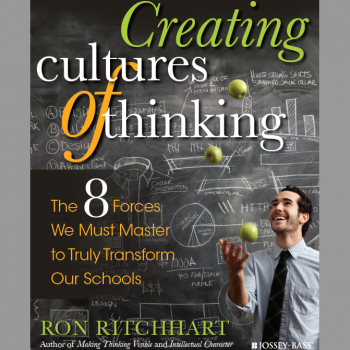Many of us have already been exposed to the concepts behind Creating Cultures of Thinking; with my new start at Havergal, it has served as a great reminder of the moral imperative of education.
Creating Cultures of Thinking, by Ron Ritchhart outline s the 8 forces “we must master to truly transform our schools”. These are: Environment, Expectations, Interactions & Relationships, Language, Modeling, Opportunities, Routines & Structures, and Time. As I was revisiting this book for the start of the year, I was reflecting on two of the forces in particular: Language and Routines.
s the 8 forces “we must master to truly transform our schools”. These are: Environment, Expectations, Interactions & Relationships, Language, Modeling, Opportunities, Routines & Structures, and Time. As I was revisiting this book for the start of the year, I was reflecting on two of the forces in particular: Language and Routines.
Language
Language defines our space. The language we use, allow, and language that are part and parcel of our traditions define what is normal, what is expected, and what is true. I wrote about this with a colleague in Dialogue Magazine and how it impacted our work starting a Gay-Straight Alliance at Greenwood College School. In it we wrote about how deliberate and careful use of language, and of space is critical to long-term success in shifting a culture. It still holds true today. Ritchhart supports this when he writes:
Being more specific in our use of language directs students to specific cognitive acts. (Ritchhart, 69)
Ritchhart suggests a deliberate approach to language use in the classroom as it relates to building community: “When a speaker refers to ‘this’ or ‘that, ‘he’ or ‘she’, the listener has to have a shared frame of reference or connection in order to make sense of what the speaker is saying.” Thus, using more specific language, yes, even pronouns! Those writing using the term ‘I’ helps to build relationships, and “we” is one of the strongest words that can be used by a leader to build capacity and collaboration behind a cultural shift because it reflects a collective ownership of the change. Deliberate use of language shows that the change is not something being done to you, it is something that ‘we are experiencing’ along with all the good and bad. It is why Grant Lichtman no longer refers to teachers as teachers. He refers to them as educators to reflect the shift in the role they occupy in the learning process.
Ritchhart also builds a strong array of language that teachers can use to support growth and risk-taking in the classroom. If “…our language both conveys intention and cues behaviour…” then we can set our classrooms up for success with the following prompts and feedback structures:
If we do it this way…
Let’s imagine that what you said was true…
Let’s try it this way…
Why don’t we look at it from another point of view before moving on…
What would person X think of this idea?
How else might we approach this?
The use of conditional language allows students to integrate their prior knowledge and seek to understand the topic/question/concept rather than just learn the rote answer/procedure/response. (Ritchhart, 79)
Routines
In many ways, it is the language that we use that supports the mission of the school. It is the language that we use that supports the disposition
that we want both in our own approach to learning, and that of the students.
In the chapter on Routines, there are a few case studies of how teachers use routines to support learning, classroom mood and tone. There is a direct connection between the routine and the language used to establish and run the routines. It is the language, I believe, that differentiates a routine for classroom management from a routine for deep learning. Rictchhart puts it this way:
An exclusive emphasis on these routines places attention more on student control and teacher delivery than on the promotion of student learning. (Ritchhart, 191)
It is the combined use of language and deep thinking routines that can shift a student’s approach to their own learning. It is this approach, when modeled by educators and leaders to students and parents that can support the cultural shift of a school away from grade-based motivation, to curiosity and wonder.
Last night, I was on Twitter and found this great new initiative www.startedupinnovation.com. This site has a great interview (totally worth the 35mins!) that addresses a tension between a parent loving that their child is fully
engaged in this teacher’s “Innovation Class”, but is worried that it is taking away from his time spent on homework and supporting his GPA. This is the tension that we are grappling with while admissions departments around the world catch up, while businesses around the world catch up, and while educators see the relevance of engagement in deep thinking as something outside of their day-to-day imperative.
Deliberate, consistent use of language and deep-thinking routines can support the shift that is required. This book serves to reinforce this message that as educators we are constantly reinforcing and modeling expectations of what it means to be a learner. This book also offers solutions and strategies, case studies and tools to use to support taking this on in a classroom, a club, a sports team, a faculty and an entire school.
While this is just a quick look at 2 of the 8 forces, it is something that I will be taking with me for the whole year ahead.
